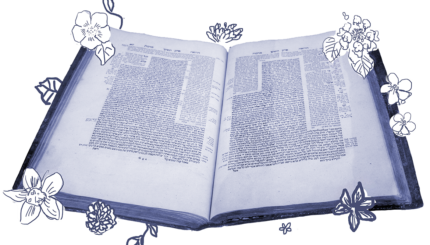I could never have anticipated the impact that reading Perek Daled (chapter four) of Megillat Esther would have on my life. In 2008, I was a student at Cambridge University, and what had started as a shyly mooted idea to organise a women’s megillah reading had been taken up
enthusiastically. After some reluctance, our student chaplain acquiesced, and even beneath the boys’ standard jokes was an undeniable note of respect.
With last-minute timing typical of students, we split up the ten chapters, found recordings to learn from, and learnt our parts. I don’t think I realised at the time that learning leyn Megillat Esther would transform my understanding of the book, and deepen my relationship with Judaism.
Applying notes to the text has been a key part of this experience – the leyning trop (cantillation) really does mirror the mood and pace of the story. I had always loved the bits of Megillat Esther which were sung to the Eicha (Lamentations) tune: remembering the exile of Mordechai’s family from Jerusalem, and as Esther prepares to approach the King uninvited, and face the same fate as Vashti. Until I learnt to read them myself, I hadn’t appreciated the depths of the words beneath them.
Each time I’ve leyned the megillah since then, and there have been five occasions (and counting!), I have felt my bond grow with these ancient, beloved words. Esther’s story has come alive in new and astounding – and sometimes disturbing – ways. I’ve discovered new characters I never realised were there (they never mentioned Hatach or Hegai in cheder [Jewish elementary school]) and I’ve noticed nuances in the narrative. The words and phrases and their tunes have stayed with me, popping up at surprising times. They inform my study of other parts of the Tanakh, enabling
new cross-readings and echoes between stories. (And I felt rather smug on one occasion when a rabbi quoted a phrase from “my perek,” and I noticed that he missed out a word!)
Reading Megillat Esther has been an enriching experience in so many other ways. In the community where I live now, it has brought together a wonderful group of like-minded friends with a variety of ages and backgrounds – some of whom I may never have spoken to otherwise. While some are deeply involved in our community, others feel alienated by Judaism, and yet reading the megillah has been a source of connection and meaning for them. To anybody who says that women’s megillah readings are a “slippery slope” away from “authentic Judaism,” I would encourage them to consider the women whom it has inspired to greater levels of Jewish knowledge, spirituality, and engagement. In addition to my feelings of connection with the text, my Hebrew skills have improved significantly, and I am finally mastering the difference between pronouncing a heh and a chet, something, embarrassingly, that I never properly achieved in cheder or even in seminary.
The readings themselves have always been memorable, both for their good decorum and clarity of reading – and simply for being fun occasions. It is incredibly refreshing to be a part of a reading where you can hear every word, when each leyner brings a unique voice to her section, and when you can feel the hours of work, effort, and worry that has gone into preparing each chapter. And we have fun! Each year, our group has picked a dressing up theme, from wigs and wings to silly hats. We also give tzedakah as a group each year, picking both a local cause and one further away.
Reading megillah has changed and enriched my Jewish life. I hope that both women who choose to leyn and those who don’t have only respect for one another. Ultimately, I see participation in reading the megillah as taking one of the many opportunities that life throws at us to bless God – to do something positive, active and public that connects us with our spiritual heritage. It makes me proud to know that I have been part of the growing movement of women’s megillah readings, and that the young girls – and boys – in our community will grow up seeing it as a normal and beautiful part of the Jewish year.
Like this post? Join the conversation through MyJewishLearning’s weekly blogs newsletter.
Are you organizing a megillah reading this year? Add it to JOFA’s international directory.
leyn
Pronounced: LANE, Origin: Yiddish, to chant Torah or other biblical texts, usually before a congregation as part of a worship service.
megillah
Pronounced: muh-GILL-uh, Origin: Hebrew, meaning "scroll," it is usually used to refer to the scroll of Esther (Megillat Esther, also known as the Book of Esther), a book of the Bible traditionally read twice during the holiday of Purim. Slang: a long and tedious story or explanation.



